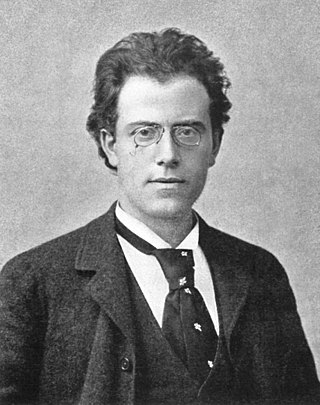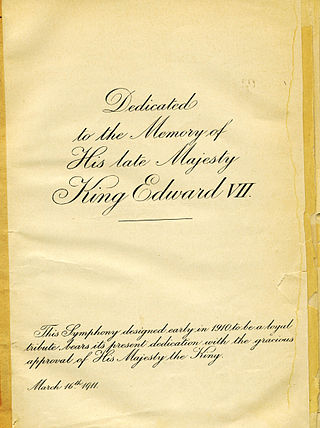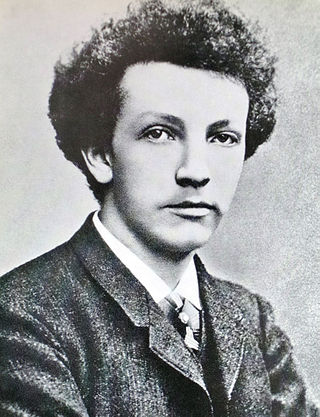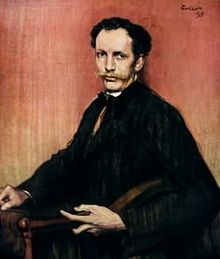The Pomp and Circumstance Marches are a series of five marches for orchestra composed by Edward Elgar, together with a sixth march created from sketches. The marches were dedicated to his friends including composer Granville Bantock and organists George Robertson Sinclair, Ivor Atkins and Percy Hull.

The Symphony No. 1 in D major by Gustav Mahler was mainly composed between late 1887 and March 1888, though it incorporates music Mahler had composed for previous works. It was composed while Mahler was second conductor at the Leipzig Opera in Germany. Although in his letters Mahler almost always referred to the work as a symphony, the first two performances described it as a symphonic poem and as a tone poem in symphonic form, respectively. The work was premièred at the Vigadó Concert Hall in Budapest, Hungary, in 1889, but was not well-received. Mahler made some major revisions for the second performance, given at Hamburg, Germany, in October 1893; further alterations were made in the years prior to the first publication, in late 1898. Some modern performances and recordings give the work the title Titan, despite the fact that Mahler only used this label for the second and third performances, and never after the work had reached its definitive four-movement form in 1896.

Capriccio espagnol, Op. 34, is the common Western title for a five movement orchestral suite, based on Spanish folk melodies, composed by the Russian composer Nikolai Rimsky-Korsakov in 1887. It received its premiere on 31 October 1887, in St. Petersburg, performed by the Imperial Orchestra conducted by the composer. Rimsky-Korsakov originally intended to write the work for a solo violin with orchestra, but later decided that a purely orchestral work would do better justice to the lively melodies. The Russian title is Каприччио на испанские темы.

The Violin Concerto in D minor, Op. 47 of Jean Sibelius, originally composed in 1904 and revised in 1905, is the only concerto by Sibelius. It is symphonic in scope and included an extended cadenza for the soloist that takes on the role of the development section in the first movement.

Sir Edward Elgar's Symphony No. 2 in E♭ major, Op. 63, was completed on 28 February 1911 and was premiered at the London Musical Festival at the Queen's Hall by the Queen's Hall Orchestra on 24 May 1911 with the composer conducting. The work, which Elgar called "the passionate pilgrimage of the soul", was his last completed symphony; the composition of his Symphony No. 3, begun in 1933, was cut short by his death in 1934.

Also sprach Zarathustra, Op. 30 is a tone poem by German composer Richard Strauss, composed in 1896 and inspired by Friedrich Nietzsche's 1883–1885 philosophical work of the same name. Strauss conducted its first performance on 27 November 1896 in Frankfurt. A typical performance lasts roughly 33 minutes.
The Young Person's Guide to the Orchestra, Op. 34, is a 1945 musical composition by Benjamin Britten with a subtitle Variations and Fugue on a Theme of Purcell. It was based on the second movement, "Rondeau", of the Abdelazer suite. It was originally commissioned for the British educational documentary film called Instruments of the Orchestra released on 29 November 1946, directed by Muir Mathieson and featuring the London Symphony Orchestra conducted by Malcolm Sargent; Sargent also conducted the concert première on 15 October 1946 with the Liverpool Philharmonic in the Philharmonic Hall, Liverpool, England.
An Alpine Symphony, Op. 64, is a tone poem for large orchestra written by German composer Richard Strauss in 1915. It is one of Strauss's largest non-operatic works; the score calls for about 125 players and a typical performance usually lasts around 50 minutes. The program of An Alpine Symphony depicts the experiences of eleven hours spent climbing an Alpine mountain.

Symphonia domestica, Op. 53, is a tone poem for large orchestra by Richard Strauss reflecting the secure domestic life valued by the composer and accordingly dedicated by him to his "dear wife and young ones."
The Symphony No. 3 in A minor, Op. 44, is a three-movement composition for orchestra written from 1935 to 1936 by the Russian composer Sergei Rachmaninoff. The Third Symphony is considered a transitional work in Rachmaninoff's output. In melodic outline and rhythm it is his most expressively Russian symphony, particularly in the dance rhythms of the finale. What was groundbreaking in this symphony was its greater economy of utterance compared to its two predecessors. This sparer style, first apparent in the Rhapsody on a Theme of Paganini, enhances the emotional power of the work.
The Wooden Prince, Op. 13, Sz. 60, is a one-act pantomime ballet composed by Béla Bartók in 1914–1916 to a scenario by Béla Balázs. It was first performed at the Budapest Opera on 12 May 1917 under the conductor Egisto Tango.
Kossuth, Sz. 21, BB. 31, DD. 75a is a symphonic poem composed by Béla Bartók inspired by the Hungarian politician Lajos Kossuth.
An offstage instrument or choir part in classical music is a sound effect used in orchestral and opera which is created by having one or more instrumentalists from a symphony orchestra or opera orchestra play a note, melody, or rhythm from behind the stage, or having a choir of singers sing a melody from behind the stage.

The tone poems of Richard Strauss are noted as the high point of program music in the latter part of the 19th century, extending its boundaries and taking the concept of realism in music to an unprecedented level. In these works, he widened the expressive range of music while depicting subjects many times thought unsuitable for musical depiction. As Hugh MacDonald points out in the New Grove Dictionary of Music and Musicians, "In the years prior to World War I these works were held to be in the vanguard of modernism."

The trumpet repertoire consists of solo literature and orchestral or, more commonly, band parts written for the trumpet. Tracings its origins to 1500 BC, the trumpet is a musical instrument with the highest register in the brass family.

The Symphony No. 2 in F minor was written by Richard Strauss between 1883 and 1884. It is sometimes referred to as just Symphony in F minor. He gave it the Opus number 12, and it also appears in other catalogues as TrV 126 and Hanstein A.I.2. It is not listed in von Asow's catalog.
The Concerto Fantasy for Two Timpanists and Orchestra is a double timpani concerto written by Philip Glass in 2000. It is paired with the Cello Concerto on Vol. I of Glass' Concerto Project, a set of eight concerti by the composer. A typical performance of the work lasts 25–28 minutes. It was written for Jonathan Haas and later recorded by Evelyn Glennie, and was premiered by Haas and Svet Stoyanov with the American Symphony Orchestra in Avery Fisher Hall, Lincoln Center, conducted by Leon Botstein. The work was commissioned jointly by the American Symphony Orchestra, the Peabody Symphony, the Milwaukee Symphony, the St. Louis Symphony and the Phoenix Symphony. In 2004, a transcription for wind ensemble was written by Mark Lortz, which debuted at Peabody Institute in 2005.

A Hero's Song, Op. 111, B. 199, also called Heroic Song for Orchestra, is a symphonic poem for orchestra composed by Antonín Dvořák between August 4 and October 25, 1897. It was premiered in Vienna in on December 4, 1898, with Gustav Mahler conducting the Vienna Philharmonic, and was later published in Berlin in 1899. Unlike Dvořák's other symphonic poems, this work is not based upon a specific text, and it may have been intended to be autobiographical. The piece is mostly energetic and triumphant, but it includes a slower section containing a funeral march. A typical performance lasts approximately 22 minutes.
Aaron Copland wrote the Symphony for Organ and Orchestra in 1924. It represents a major work in the composer's oeuvre, as it was his first fully realized orchestral work, his first work for organ, and the first piece whose orchestration he heard. It was premiered on January 11, 1925, in New York. In 1928, Copland re-orchestrated the work without organ as his Symphony No. 1, rewriting the organ part in the brass and adding saxophone.

Taillefer, Op. 52, TrV 207, is a cantata for choir and orchestra composed by Richard Strauss in 1903. The text is a rendering of the medieval tale Taillefer by the German poet Ludwig Uhland (1787–1862). The piece was written to celebrate the centenary of Heidelberg University and was premiered on the same day that Strauss received his honorary doctorate from the university, on 26 October 1903 in the newly built Heidelberg Town Hall with Strauss conducting. It is written for a mixed chorus with three soloists, tenor (Taillefer), baritone, and soprano, with a large orchestra. The work was performed at the last night of The Proms in 2014.













